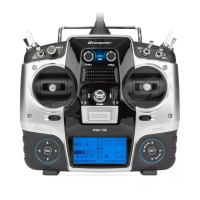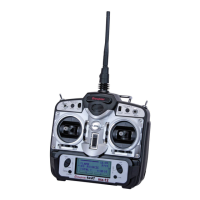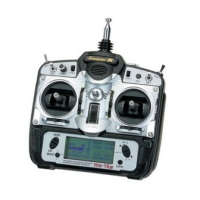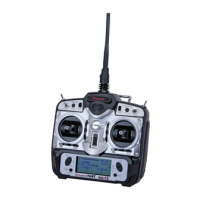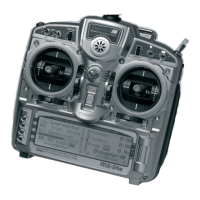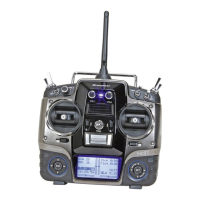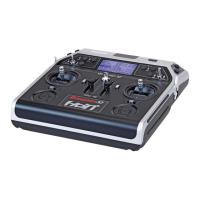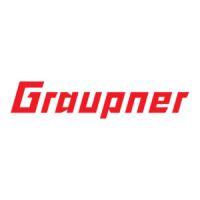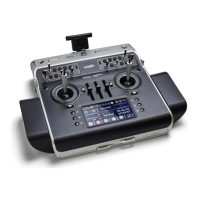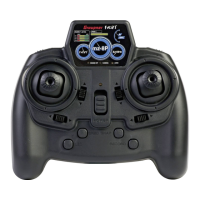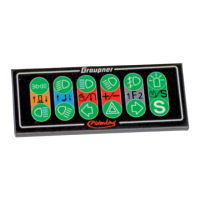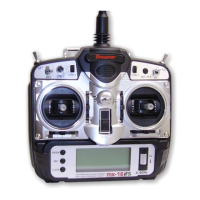
Do you have a question about the GRAUPNER mx-16 ifs and is the answer not in the manual?
| Channels | 16 |
|---|---|
| Frequency | 2.4 GHz |
| Telemetry | Yes |
| Display | LCD |
| Weight | 1100 g |
Defines intended use and covers hazards from rotating parts, electrical issues, and general handling.
Guides on installing receiver, aerial, servos, and linkages correctly.
Covers pre-flight checks, aerial, safe operation, battery, and motor suppression.
Guidelines for safe model operation, battery checks, and charging.
Covers servo filters, speed controllers, ignition, static, care, FCC rules, and liability.
Introduces the 2.4 GHz iFS technology and system capabilities.
Highlights graphic screen, intuitive controls, and programming structure.
Lists key features of the high-technology micro-computer system.
Highlights bi-directional communication and simplified programming.
Details stick modes, servo display, and model memory features.
Lists various mixer functions and programmable features like Fail-Safe.
Lists transmitter/receiver specs and included components/accessories.
Covers transmitter battery types, monitoring, and charging procedures.
Explains the battery timer and screen indicators during operation.
Discusses receiver power options, charging, and general battery care.
Lists optional battery chargers and their compatibility.
Covers adjusting stick length and opening/closing the transmitter case.
Details changing stick modes and adjusting stick centring tension.
Instructions for neckstrap attachment and identification of controls.
Explains default control states and flexible assignment options.
Explains the DSC socket's function and connection requirements.
Identifies components on the transmitter's back panel.
Explains LCD indicators and basic navigation with buttons.
Details display indicators and the functions of the rotary cylinder.
Explains the functions of ENTER, ESC, and CLEAR buttons.
Describes rotary cylinder operation and function fields like SEL, STO, CLR.
How to adjust screen contrast and view position displays.
Visual representation of servo positions for different model types.
Discusses iFS benefits and expanded RF module programming.
Covers battery status, aerial fit, and transmitter switch-on sequence.
Steps to configure output power and hopping mode for regulatory compliance.
Introduces the XR-16iFS receiver and the binding procedure.
Guides on binding subsidiary receivers to the transmitter.
Procedure for range checking and reassigning receiver servo outputs.
Covers country settings, fail-safe configuration, and low voltage alerts.
Information on servo sockets, polarity, and power supply connection.
Steps to enter receiver programming and navigate options.
How to assign control channels to specific receiver outputs.
Setting national parameters and configuring fail-safe behavior.
Adjusting fail-safe timing, telemetry, and receiver reset.
Setting specific fail-safe positions and exiting the programming mode.
General installation notes for receiver and components in the model.
Provides notes on installing servos, linkages, and switches.
Defines control functions, transmitter controls, and control channels.
Defines mixers, switches, and transmitter control switches.
Explains the basic procedure for assigning switches and control switches.
Provides examples of how transmitter control switches are used.
Explains the function and display of digital trims.
Details Ch 1 trim usage for specific model types and functions.
Describes the program's support for fixed-wing models and basic setup.
Lists pre-defined mixers available for fixed-wing models.
Details receiver socket assignments for normal tail types and V-tails.
Provides notes on servo connections and model type settings.
Details receiver socket assignments for delta and flying wing models.
Table and guidance for resolving incorrect servo rotation.
Introduces helicopter program capabilities and beginner setup.
Describes helicopter mixers, flight phases, and timer functions.
Details receiver socket assignments specific to model helicopters.
Provides installation notes and discusses transmitter compatibility.
Steps to select a vacant memory and initialize model type.
How to choose between fixed-wing or helicopter model types.
Importance of confirming model type and initial transmitter settings.
Procedures for selecting and erasing model memories.
How to copy data from one model memory to another.
Detailed steps for copying model data and handling security queries.
Introduces essential basic settings for fixed-wing models.
How to enter a model name and select the stick mode.
Configuring motor settings and tail type for fixed-wing models.
Configuring tail type and aileron/flap mixer options.
Setting up and assigning timers (stopwatch, flight timer) to controls.
Explains stopwatch and count-down timer functions and selection.
Configuring flight phases and reassigning receiver servo outputs.
Introduces essential basic settings for helicopter models.
How to enter model name and select stick mode for helicopters.
Choosing the correct swashplate type based on servo configuration.
Setting main rotor direction and understanding swashplate mixer functions.
Adjusting collective pitch minimum and throttle curve settings.
Configuring timers and count-down functionality for helicopters.
Configuring flight phases and receiver output assignments.
Reassigning receiver outputs and common applications.
How to adjust servo direction, neutral point, and travel.
Adjusting servo rotation direction for proper control surface movement.
Fine-tuning servo centre and travel limits.
Adjusting servo travel symmetrically or asymmetrically.
Identifies supplementary controls and the procedure for assigning them.
Detailed steps for assigning controls and switches to inputs.
Adjusting transmitter travel for assigned controls, including asymmetrical settings.
Identifies supplementary controls and their default assignments for helicopters.
Steps for assigning helicopter controls and switches to inputs.
Adjusting transmitter travel for assigned helicopter controls.
Explains and guides on setting up the throttle limit function for helicopters.
How to adjust gyro gain and set up the gyro sensor.
Procedures for setting idle and adjusting the throttle curve.
How the Ch 1 trim interacts with the throttle limit control.
Introduces Dual Rate and Expo functions for adjusting flight characteristics.
How to set up and switch between Dual Rate values.
How to set up and switch between Exponential values.
How Dual Rate and Expo values are superimposed.
Overview of Dual Rate/Expo for roll, pitch-axis, and tail rotor.
How to set up and switch between Dual Rate values for helicopters.
How to set up and switch between Exponential values for helicopters.
How Dual Rate and Expo values are superimposed for helicopters.
How to set up flight phases and adjust trims for control surfaces.
Adjusting trim values for different flight phases.
Understanding the phase trim display and relevant notes.
Explains the basic function of mixers and provides an example.
Lists and describes various pre-programmed wing mixers.
Explains how differential aileron travel reduces adverse yaw.
How to set the neutral point (offset) for mixers.
Describes mixers for aileron-rudder, brake-flap, and brake-elevator interactions.
Explains differential flap and brake-aileron mixers.
Describes brake mixers and the crow/butterfly system.
Explains differential reduction and elevator-flap mixers.
Explains flap-aileron mixers and differential reduction.
Overview of helicopter mixers and flight phase setup.
Explains five-point curves for collective pitch, throttle, and tail rotor.
Detailed procedure for programming collective pitch curves.
Defining throttle curves and notes on throttle limit usage.
Recommendations for using the throttle limit function and typical throttle curves.
Setting up speed governors and tail rotor torque compensation.
Defining the tail rotor control curve for helicopter stability.
How to adjust gyro gain and set up the gyro sensor.
Practical procedure for adjusting throttle and collective pitch curves.
Essential steps for setting up throttle and collective pitch curves.
Adjusting lift and rotational speed for hover and climb.
Adjusting descent settings and final notes on throttle limit.
Crucial safety advice for starting the motor and handling the helicopter.
Introduction to auto-rotation settings and pitch curve setup.
Setting the throttle curve for auto-rotation mode and practice.
Adjusting tail rotor settings for auto-rotation descent.
General information about free mixers and their parameters.
Explains mixer ratio, neutral point, and switch channel input.
Steps for programming mixer ratios and defining mixer destinations.
How to erase mixers and assign switches to them.
Explains mixer effects, helicopter-specific mixers, and mixer ratio programming.
How to set the mixer neutral point using the offset function.
Defining symmetrical and asymmetrical mixer ratios.
Provides examples of mixer applications and setup.
Explains swashplate mixer functions for collective pitch, roll, and pitch-axis.
How to adjust swashplate mixer ratios and directions.
General techniques for programming a fixed-wing model.
Importance of correct mechanical installation and servo setup.
Sensible transmitter control layout and model type selection.
Configuring throttle/brake stick and understanding mixer availability.
Step-by-step guide to programming a new fixed-wing model.
Selecting model type and configuring basic settings like stick mode.
Adjusting servo settings and selecting wing mixer options.
Adjusting mixers for flaps, ailerons, and their interactions.
Explains Dual Rate and Expo functions for adjusting flight characteristics.
Steps to include an electric power system using CTRL 7.
Using switches for ON/OFF control of electric motors.
Implementing a three-stage solution for electric motor control.
Using Ch 1 stick for motor control and butterfly system.
Initial setup for motor control and brake systems.
Verifying mixer effects and setting up brake and flap mixers.
Using the Ch 1 stick or switches to operate timers.
Programming up to three flight phases and adjusting trims.
Connecting and configuring servos to run in parallel.
General notes on installing RC systems in delta and flying wing models.
Recommended servo connections and base settings for delta/flying wings.
Adjusting wing mixers for delta and flying wing models.
Adjusting elevator effects and mixer compensation for delta/flying wings.
Introduction to F3A models and basic setup process.
Adjusting servo settings and configuring base settings for F3A models.
Assigning controls for retracts, mixture, and programming landing aid mixers.
Using mixers to correct unwanted movements in F3A models.
Correcting model deviation in vertical flight and configuring fail-safe settings.
Introduces basic programming for model helicopters and initial setup.
Steps to select model type and a free memory slot for helicopters.
Entering model name and configuring stick mode, rotor direction.
Selecting swashplate type and adjusting servo settings.
Adjusting throttle curves and notes on throttle limit usage.
Activating the auto-rotation switch and adjusting gyro gain.
Adjusting collective pitch curves for hover and auto-rotation.
Setting throttle curve for auto-rotation and transition phases.
Setting tail rotor compensation and adjusting gyro gain.
Activating flight phases and assigning timers.
Installing and configuring a speed governor for helicopters.
Setup for using MX-16iFS as a pupil transmitter in a trainer system.
Setup for using MX-16iFS as a teacher transmitter with total control transfer.
Verifying the proper functioning of the trainer system and connections.
Identifying and troubleshooting common errors in the trainer system.
Details trainer mode operations and lead compatibility.
Explains applications of magic box and the programming adapter.
Details the PRX receiver power supply unit and its features.
Must observe output stages and national regulations for country compliance.
Required national settings for FCC, ETSI, IC directives, especially for Hopping Mode 1.
Declares compliance with FTEG and R&TTE directives, listing applied standards.
Lists service locations and contact information for warranty claims.
Explains warranty terms, exclusions, and required information for claims.
